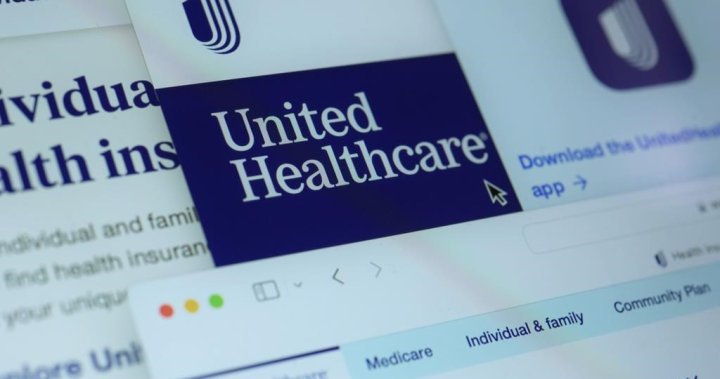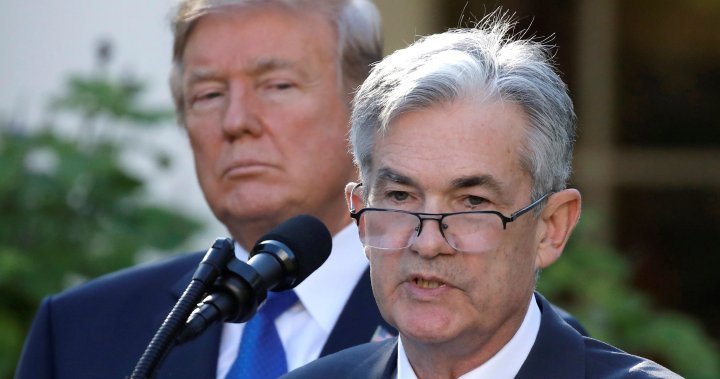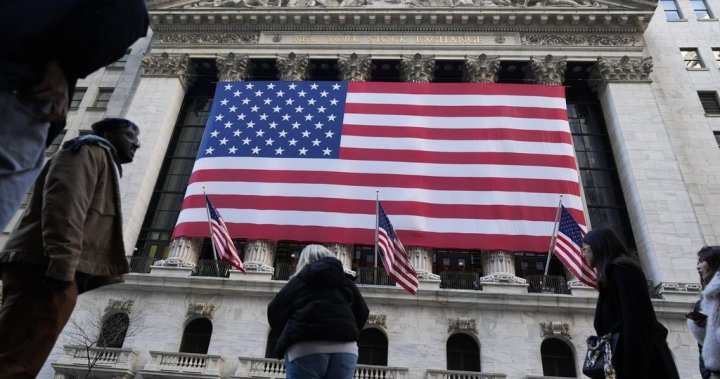UnitedHealth’s stock drops over 22% for worst day since 1998. Here’s why – National

Most U.S. stocks climbed Thursday, but the worst drop for UnitedHealth Group in a quarter of a century kept Wall Street in check.
The S&P 500 edged up by just 0.1%, even though three of every four stocks climbed in the index. The Nasdaq composite slipped 0.1% in a mostly steadier performance following its sell-off the day before.
The Dow Jones Industrial Average dropped 527 points, or 1.3%, largely because of just stock. UnitedHealth Group lost more than a fifth of its value and fell 22.4% following a weaker-than-expected profit report.
Helping to lead the way higher on Wall Street was Eli Lilly, which jumped 14.3% after the drugmaker reported encouraging results for a once-daily pill that could help treat people with obesity and diabetes.
Stocks of companies in the oil-and-gas industry also rallied after the price of crude rose to recover some of its sharp losses taken this month. Diamondback Energy jumped 5.7%, and Halliburton climbed 5.1%.
The S&P/TSX composite index closed up 86.02 points at 24,192.81.

Technology stocks held firmer after global heavyweight Taiwan Semiconductor Manufacturing Co. reported a profit for the latest quarter that matched analysts’ expectations. Perhaps more importantly, it also said it hasn’t seen a drop-off in activity from its customers because of President Donald Trump’s trade war, as some other companies have suggested.
Still, the company known as TSMC was cautious. “While we have not seen any changes in our customers’ behavior so far, uncertainties and risks from the potential impact from tariff policies exist,” Chief Financial Officer Wendell Huang said. TSMC’s stock that trades in the United States added 0.1%.
What happened at UnitedHealth?
They helped offset UnitedHealth’s drop, its worst since 1998, after it slashed its forecast for financial results this year. It was surprised by how much care its Medicare Advantage customers were getting from doctors and outpatient services, which was above the company’s expectations.
The company’s first earnings miss since 2008 and accompanying bleak forecast sent investors to the exits, as they were hoping the U.S. insurer would maintain its profit outlook on expectations that demand for medical services would be similar to 2024. UnitedHealth has historically provided a conservative forecast, at least two investors said.

Get weekly money news
Get expert insights, Q&A on markets, housing, inflation, and personal finance information delivered to you every Saturday.
“Nobody was expecting this level of a miss or cut to guidance,” said Kevin Gade, chief operating officer of Bahl & Gaynor, which owns UnitedHealth’s stock.
The U.S. health insurance industry has been grappling with increased costs since mid-2023 due to a surge in demand for healthcare services under government-backed Medicare plans for older adults or individuals with disabilities.
While other insurers slumped on UnitedHealth’s news, they recovered some losses after rival Elevance Health said it was sticking with its current quarterly outlook, even as UnitedHealth shares continued to sink.

Another high-profile stock, Nvidia, weighed on the market after sinking a second straight day following its disclosure that new export limits on chips to China could hurt its first-quarter results by $5.5 billion. It sank 2.9% and was the second-heaviest weight on the S&P 500.
All told, the S&P 500 added 7.00 points to 5,282.70. The Dow Jones Industrial Average dropped 527.16 to 39,142.23, and the Nasdaq composite slipped 20.71 to 16,286.45.
Tariff uncertainty remains
Uncertainty still remains high about tariffs, which Trump wants to bring manufacturing jobs back to the United States and trim how much more it imports than it exports. Economists worry that the tariffs could cause a recession if fully implemented and left in place for a while.
Trump on Thursday offered some encouraging signals that negotiations with other countries could lead to lower tariffs, which is what Wall Street is hoping for.
The uncertainty about what will happen in Trump’s on-again-off-again rollout of tariffs, though, could damage the economy by itself. Federal Reserve Chair Jerome Powell helped send stocks lower Wednesday when he reiterated that Trump’s tariffs appear to be larger than the central bank was expecting, which could in turn slow the economy and raise inflation more than it had earlier thought.
That could set up a dilemma for the Fed. It could cut interest rates to help the economy, but that would also push inflation higher.
It has no good tool to fix both at the same time. Powell said again on Wednesday that the Fed would wait to see how conditions play out more before moving on interest rates.
Trump criticized that stance Thursday, saying the Fed is “always TOO LATE AND WRONG.” He also said, “Powell’s termination cannot come fast enough!”

That could spook Wall Street. An independent Fed able to act without influence from the White House is one of the primary reasons the United States has benefited from its reputation as a safe place to invest. History suggests central banks with more autonomy tend to have economies with lower and more stable inflation.
Research also suggests Trump’s past attacks on the Fed in favor of lower interest rates may have helped drive expectations in financial markets for lower rates, which in turn may have had some influence on the Fed. But conditions are different this time around from when inflation was low during Trump’s first term.
“This request for lower rates could backfire if markets perceive that going forward the Fed will be less committed to low and stable inflation,” said Francesco Bianchi, an economics professor at Johns Hopkins University.
In the bond market, the yield on the 10-year Treasury rose to 4.32% from 4.29% late Wednesday. It had been easing for much of this week, following last week’s scary rise. That sudden climb last week had raised concerns that Trump’s frenetic moves in his trade war may be causing investors worldwide to lose faith in U.S. investments as the world’s safest.
Reports Thursday morning came in mixed on the U.S. economy. One said fewer U.S. workers applied for unemployment benefits last week than economists expected. That’s the latest signal that the job market remains relatively solid. But a second report said manufacturing in the mid-Atlantic region unexpectedly flipped to contraction from growth.
In stock markets abroad, indexes slipped 0.6% in France and 0.5% in Germany. The European Central Bank cut its main interest rate, which is something that often pushes stock prices higher. But investors worldwide had already been expecting the move for a while.
In Asia, indexes were stronger. Stocks rose 1.6% in Hong Kong and 1.3% in Japan.
AP Business Writers Yuri Kageyama and Matt Ott contributed. Additional files from the Canadian Press and Reuters.









